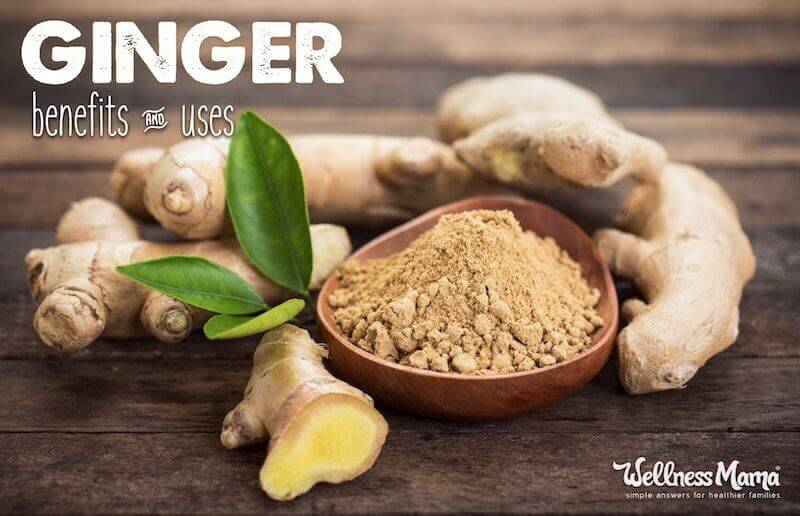Ginger root is one of the oldest and most popular natural remedies, and in my opinion also one of the most delicious. Ginger root is very easy to find in most places both in fresh and dried (and even pickled and candied) preparations.
This is one herb I always keep on hand (I know, say that a lot!) for use in natural remedies for upset stomachs, respiratory issues, and even skin problems!
What Is Ginger Root?
According to Mountain Rose Herbs, ginger root the most widely used and available herbal remedy on the planet, with billions of people using it every day as both food and medicine. It’s certainly spicy, but there are ways to adjust the taste for different palates (ahem, kids) like in this Golden Milk recipe.
Ginger is a root (a rhizome related to the turmeric root, to be exact). It grows as a tropical perennial with green shoots (they almost resemble bamboo, a related rhizome) with lance-shaped leaves and stalks of white or yellow flowers.
As the name “ginger root” suggests the part we use is the brown root system running underground between sprouts. This root when peeled contains a fibrous, juicy core that can be grated, chopped, minced, or ground.
So, why am I such a fan of this particular root?
I’m so glad you asked!
Culinary and Medicinal Uses in History
Ginger root grows in many places today and is widely available in most grocery stores both as a fresh root and a dried and powdered spice. That wasn’t always the case, though.
Originally from southern Asia, ginger root was one of the first spices to be brought and traded from the Orient in ancient and medieval times. Arab spice traders would go to great lengths to protect their source and even made up stories of ginger fields stalked by a fierce people called “troglodytes” to do so.
In this way ginger gained quite a reputation as a sought-after commodity and even became woven into fables and literature. Even Shakespeare wrote in Love’s Labour Lost “had I but one penny in the world thou shouldst have it to buy ginger-bread.”
While ginger is certainly delicious for culinary use in recipes like gingerbread, ginger tea, curry, and the like, Chinese and Japanese medicine practitioners learned early on just how beneficial ginger is for the health as well.
Health Benefits of Ginger Root
The best of East meets West in ginger, because current medical research agrees that ginger has a myriad of health benefits.
Ginger root (in dried or fresh forms) is said to help:
- soothe digestive disturbances
- alleviate nausea (great in early pregnancy)
- reduce fever
- calm coughing and respiratory troubles
- stimulate the circulatory system
- relieve muscle aches and pain
- get rid of dandruff
- lower cholesterol
- lower blood pressure and cancer risk
Chinese or Japanese practitioners typically use fresh ginger medicinally to relieve dryness and heat, and dried to relieve dampness and chill.
How to Use Fresh or Dried Ginger Root (+ Recipes)
 I probably use ginger the most in cooking, but after years of experimenting I now regularly make a couple of natural remedies to get the benefits of ginger that way.
I probably use ginger the most in cooking, but after years of experimenting I now regularly make a couple of natural remedies to get the benefits of ginger that way.
Fresh and dried ginger root seem to be equally beneficial in trials, so here are a few of my favorite uses for getting either (or both) in the diet on a daily basis:
In the Kitchen
- Ginger Root Tea – Simmer 3/4 teaspoon (0.5 to 1.0 grams) of chopped fresh ginger in 1 cup of hot water for five minutes in a closed teapot. Strain and serve.
- Golden Milk – Try this delicious Turmeric Tea recipe (we call it Golden Milk) with the benefits of turmeric, cinnamon, and healthy fats.
- Gingerbread Latte – Missing Starbucks? Make a Superfood Gingerbread Latte at home with this recipe featuring fresh or dried ginger.
- Ginger Ale – Make a healthy soda alternative by brewing healthy ginger ale at home!
- Curries and Stir-fry Recipes – Add to foods like curries and stir-fry as a delicious spice. I also love fresh ginger in this Sweet Asian Dressing.
- Soups – This Carrot Ginger Soup recipe is a warming winter staple around our house.
- Gingerbread cookies, of course! – This list could not be complete without a real-food version of warm and spicy Gingerbread Cookies made with molasses and fresh dates.
In Home Remedies
- Cough and cold remedies – I use ginger root both fresh and dried in several homemade cold and cough remedies. Try this cough syrup the next time illness strikes (or make it in cough drop form).
- Sore throat spray – Soothe a sore throat quickly with this homemade herbal sore throat spray.
- Wellness shots or tonics – Ginger added to elderberry syrup or elderberry tea offers extra immune benefits to ward off sickness in the first place or recover faster. Also try a shot of this spicy fire cider for a boost of wellness.
- In capsules – Fill empty capsules (made of gelatin) with dried ginger to take it in therapeutic doses to relieve morning sickness, indigestion, or even menstrual cramps. Or, buy ginger capsules.
- Added to a hot bath – Add a few tablespoons of dried, powdered ginger root added to a hot bath is effective in relieving sore muscles or body aches (can also lower fever).
I’m sure there are other ways to use ginger around the home, but these are the ones I’ve tried and love so far!
Is Ginger Safe?
There are warnings in both traditional Chinese medicine and some medical texts about using ginger during pregnancy, though it is generally agreed that ginger can be used in moderation. Always check with a doctor or midwife to be sure. Studies in the late 1990s found that eating as much as 2 to 3 tablespoons of raw ginger or 5 to 8 tablespoons of dried ginger daily will not stimulate uterine contraction, so it seems pretty safe to say most of us are not consuming enough ginger to cause a problem.
While in the right amount ginger helps digestive, excessive use may in fact cause gastrointestinal upset. As always, moderation and a varied diet is best.
Where to Get Ginger Root
Fresh organic ginger is available in many grocery stores. For ease of storage, dried ginger root is another great option. I prefer to buy dried ginger root in bulk online whenever possible.
Have you ever used ginger? How did it work for you? Share below!



Leave a Reply